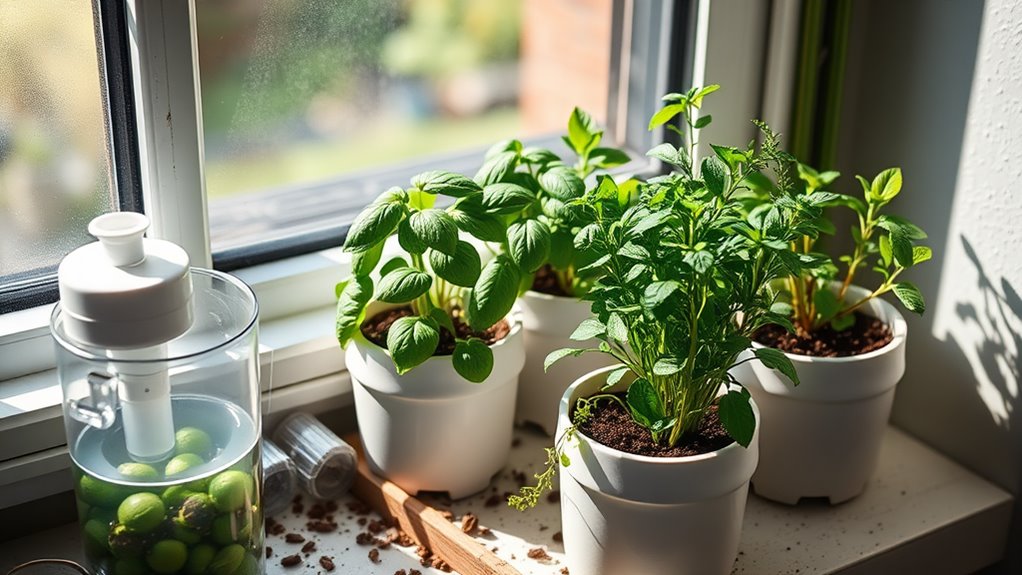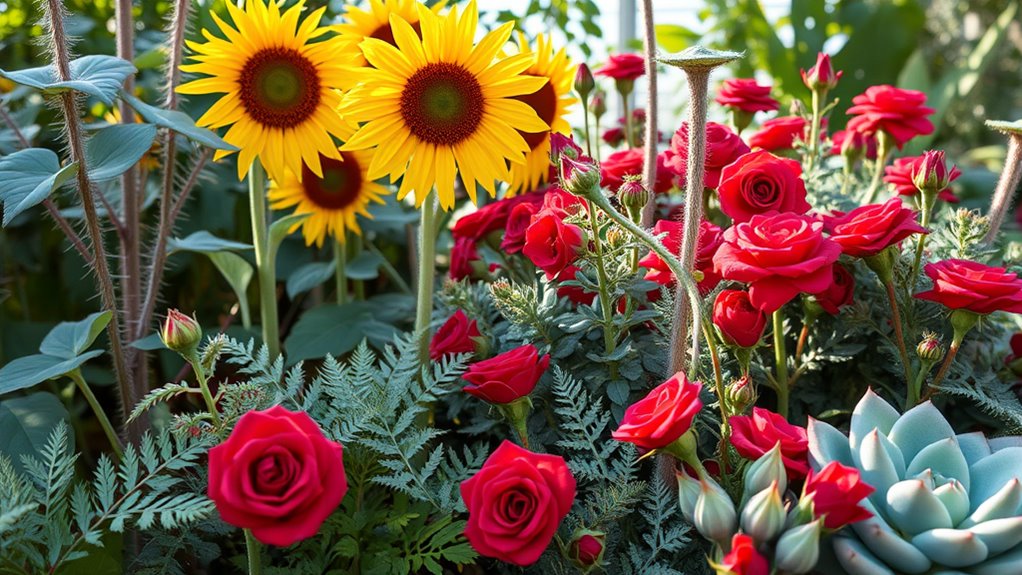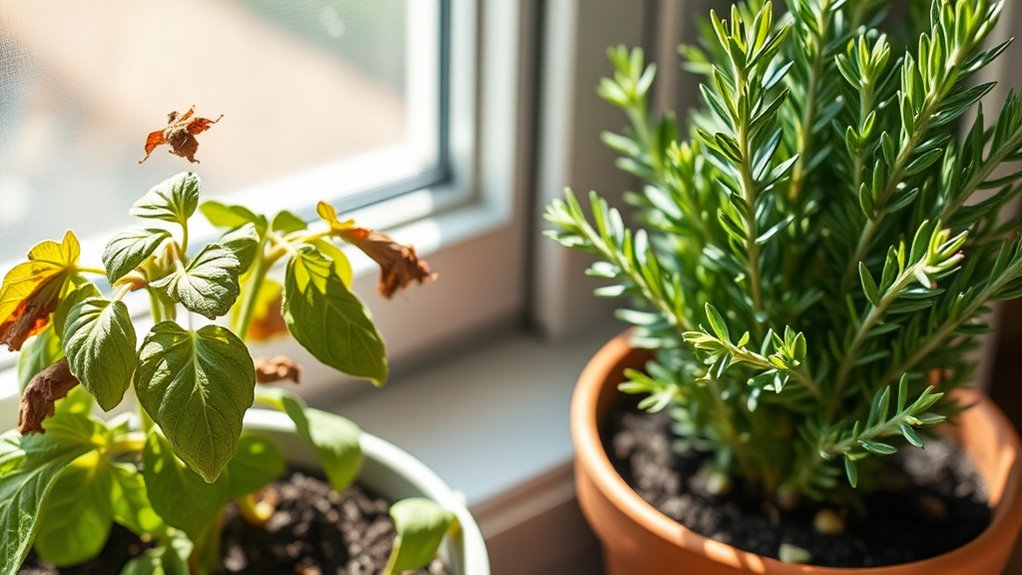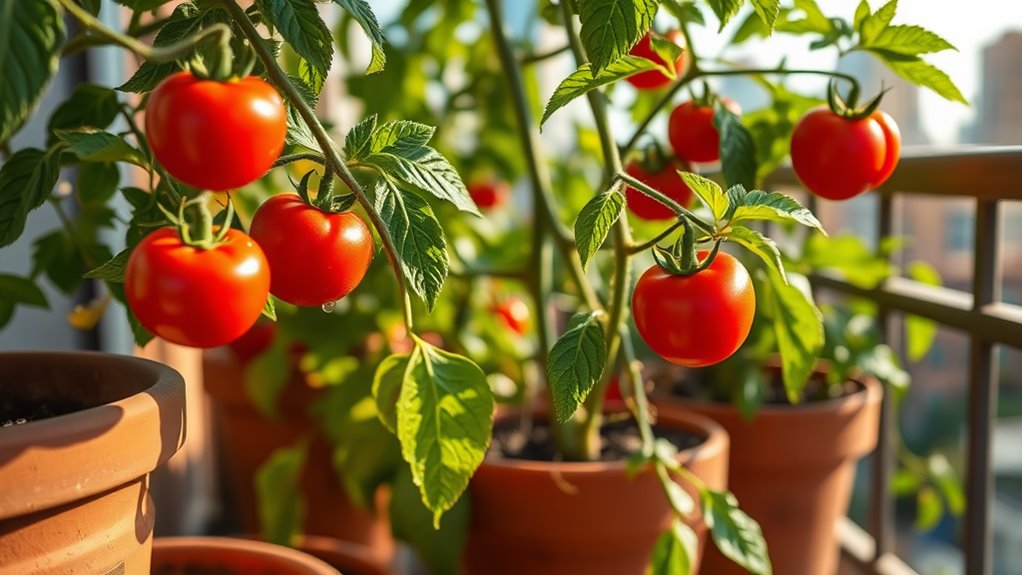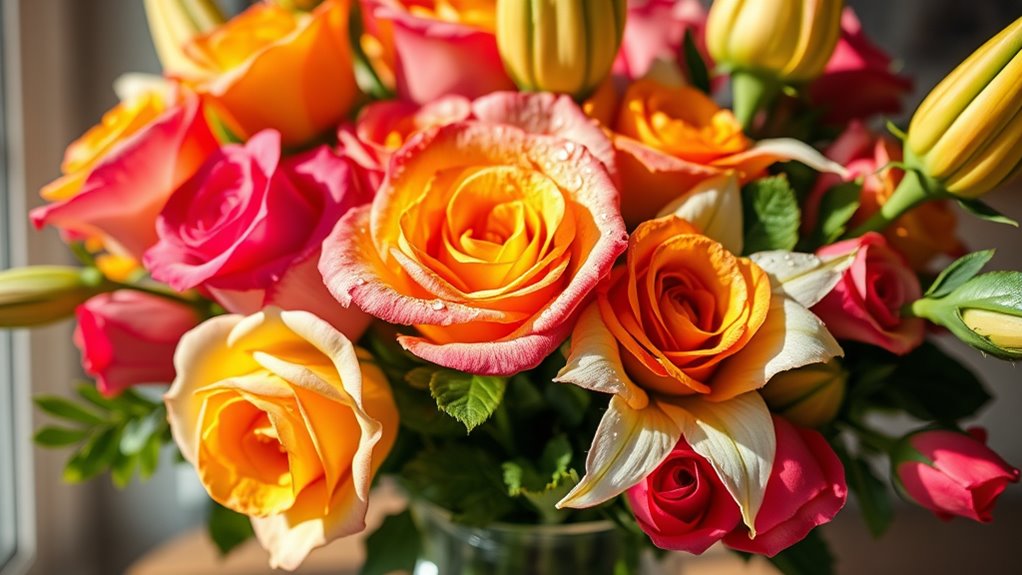I Never Buy Herbs Anymore Thanks to This Simple Setup
You never have to buy herbs again with this simple indoor setup that brings fresh flavors right to your kitchen. Start by gathering sturdy pots with drainage holes, high-quality potting mix, and seeds or seedlings for easy-grow varieties like basil or mint. Place them on a sunny windowsill or use grow lights for optimal light, then water deeply with room-temperature water to keep soil moist but not soggy, and add fertilizer occasionally. You’ll enjoy peak freshness, save money, and cut down on waste, so stick around for more on choosing and caring for your herbs.
Key Takeaways
- Grow fresh herbs at home to avoid chemicals and quick wilting of store-bought ones.
- Set up a simple indoor system using windowsills, pots, and basic supplies for easy growth.
- Choose low-maintenance herbs and provide them with adequate sunlight and water.
- Follow a routine of regular care, like checking soil moisture and rotating pots.
- Enjoy long-term savings, fresher flavors, and reduced waste from home harvesting.
The Problem With Store-Bought Herbs
While you might grab store-bought herbs for convenience, they’ve got notable downsides that impact quality and value.
Store-bought herbs are often harvested early and treated with chemicals, diminishing their fresh aroma and nutritional potency compared to options from herb growing indoors. You’ll notice they wilt quickly, leading to waste and frequent repurchases that inflate costs over time.
Plus, they may contain pesticides that affect taste and health, offering less flavor bang for your buck. With container gardening, you can grow flavorful herbs like basil or mint in limited spaces for a more sustainable option.
In contrast, herb growing indoors promises peak freshness without these compromises, making it a wiser long-term choice for vibrant, cost-effective herbs.
By adopting a simple indoor setup, you can achieve flavorful year-round cooking with consistently fresh herbs.
Discovering My Simple Indoor Setup
After ditching store-bought herbs’ drawbacks, you’ll find my straightforward indoor setup transforms your kitchen into a thriving herb haven with minimal effort. It uses everyday spaces like windowsills to create a self-sustaining system, where herbs grow steadily under natural light, reducing waste and ensuring freshness. This approach lets you harvest as needed, fostering a greener routine, and fresh flavors can be easily achieved by following basic gardening principles from the knowledge base. By incorporating low-maintenance herbs from the nine resilient options, you can achieve effortless growth in this setup.
To highlight the setup’s advantages, compare it below:
| Aspect | Store-Bought Herbs | Indoor Setup |
|---|---|---|
| Freshness | Often wilts quickly | Always at peak |
| Availability | Limited by stores | On-demand harvesting |
| Sustainability | High waste | Eco-friendly growth |
| Cost-Effectiveness | Recurring expense | Long-term savings |
| Ease | Requires shopping | Simple daily access |
Essential Materials for Growing Herbs
To grow your own herbs indoors, gather a few key materials that form the foundation of a successful setup. By incorporating one extraordinary herb, you can discover herb planting secrets that elevate your garden’s success.
You’ll need sturdy pots with drainage holes to prevent root rot and ensure proper airflow. Opt for a high-quality, well-draining potting mix enriched with organic matter for optimal nutrient delivery.
Select fresh herb seeds or vigorous seedlings, such as basil, mint, or rosemary, tailored to your space and taste.
Don’t forget reliable light sources—think sunny windowsills or energy-efficient grow lights—to mimic natural conditions.
Also, include a precise watering can and balanced, slow-release fertilizer to promote healthy, flavorful growth.
By adopting organic methods, you might experience an unexpectedly bountiful harvest, inspired by a transformative journey in gardening.
Step-by-Step Setup Instructions
Now that you’re ready with your essential materials, start by gathering all the supplies you’ll need for your herb setup, such as pots, soil, and seeds, to ensure everything’s on hand. Proper soil preparation is crucial for healthy plant growth.
Next, assemble your setup by arranging the pots in a sunny spot and filling them with the right amount of soil for optimal growth.
You’ll find this straightforward process makes growing herbs both efficient and rewarding as you move forward.
Remember, avoiding common mistakes is key to maintaining healthy herbs.
Gather Supplies
Gathering the right supplies sets the foundation for your herb buying setup. You’ll need essentials that make growing herbs simple and rewarding, sparking excitement for self-sufficiency. Start by selecting items that fit your space and budget, ensuring they’re durable for long-term use.
| Supply Item | Emotional Boost |
|---|---|
| Herb Seeds | Joy of watching new life emerge |
| Pots and Trays | Pride in creating your own oasis |
| Quality Soil Mix | Satisfaction from nurturing growth |
| Basic Tools (e.g., trowel) | Excitement of hands-on discovery |
Focus on these to build anticipation for your setup.
Assemble Setup
With your supplies gathered, you easily assemble your herb setup by following these straightforward steps, starting with preparing a suitable space to ensure everything runs smoothly from the start.
First, select a sunny, well-ventilated spot like a windowsill or patio, and clean it to prevent pests. Next, arrange your pots on a drainage tray.
Then, add a layer of gravel for better water flow, fill with soil, and plant seeds or seedlings at the proper depth. Water lightly until damp, position in your space, and label each pot.
Finally, cover with a light mesh if needed to protect from bugs. Now, you’re ready to watch them thrive!
Choosing the Right Herbs to Plant
When you’re selecting herbs for your garden, start by exploring various herb varieties that align with your needs, like culinary options such as basil or medicinal ones like echinacea.
You’ll want to match these varieties to your available space and usage, ensuring they fit your lifestyle and preferences.
Next, assess each herb’s growth requirements, including sunlight, water, and soil pH, to guarantee they flourish in your specific environment.
Understanding the scientific principles behind herb interactions can further improve your garden’s health and productivity.
For better garden results, consider companion planting basil near tomatoes to boost growth and pest resistance.
Herb Varieties
When you’re planning your herb garden, choosing the right varieties sets the foundation for a thriving setup that suits your space, climate, and needs.
Start by assessing your culinary preferences—opt for basil if you crave pesto, or rosemary for roasted meats. For small areas, select compact options like thyme or parsley, which grow well in pots.
Consider climate tolerance; hardy perennials such as lavender withstand colder weather, while heat-loving annuals like cilantro flourish in warmer regions.
Balance your selection with a mix of fast-growing herbs for quick harvests and slower ones for ongoing yields, ensuring a versatile garden that minimizes waste.
Growth Requirements
Once you’ve selected your herb varieties, focus on their growth requirements to pick plants that will thrive in your specific conditions. By matching herbs to your environment’s sunlight, soil, and climate, you’ll ensure healthy, productive growth without hassle.
-
Sunlight Needs: Assess your space’s light levels; full-sun herbs like basil require 6-8 hours daily, while shade-tolerant ones like mint thrive with 3-4 hours to prevent leaf burn.
-
Soil Requirements: Test your soil’s pH and drainage; well-drained, alkaline soil suits rosemary and thyme, whereas nutrient-rich, moist soil supports cilantro and basil for optimal root development.
-
Water and Temperature Factors: Consider your watering habits and temperatures; drought-resistant sage needs infrequent watering in warm spots, but basil demands regular moisture and milder conditions to flourish.
Daily Care and Watering Tips
While herbs thrive with minimal fuss, you’ll need to establish a simple daily routine to keep them healthy and productive. In extreme heat, remember to use deep watering methods to help maintain soil moisture and prevent dehydration.
Each morning, check soil moisture by inserting your finger an inch deep; water only if it feels dry to avoid root rot. Use room-temperature water and target the base to prevent fungal issues.
For optimal growth, position herbs in bright, indirect light and rotate pots weekly for even exposure. Lightly prune dead leaves to encourage bushiness, and harvest regularly to promote fresh growth.
This routine ensures vibrant, flavorful herbs with minimal effort. Additionally, incorporating expert watering techniques can help prevent common mistakes and further enhance plant hydration for thriving results.
Troubleshooting Common Growing Issues
Even though you’ve established a solid daily routine, common growing issues like pests, nutrient deficiencies, or wilting can still crop up with your herbs; you’ll want to identify and fix them quickly to keep your plants thriving.
Early detection is key, so monitor regularly for signs.
-
Pests: Check leaves and stems daily for bugs like aphids; apply insecticidal soap or neem oil immediately to prevent spread and protect your setup.
-
Nutrient Deficiencies: Spot yellowing or stunted growth; test soil pH and add organic fertilizers, such as compost tea, to restore balance and promote healthy foliage.
-
Wilting: Examine roots for rot or dryness; adjust watering habits and ensure proper pot drainage to revive plants and maintain vigor.
Harvesting and Using Fresh Herbs
As your herbs thrive from your careful care, you’ll harvest them at peak freshness by snipping leaves just before they flower, typically in the early morning when oils are most potent.
Choose sharp, clean shears for precise cuts, leaving at least two-thirds of the plant intact to encourage regrowth. For herbs like basil or cilantro, pinch stems above leaf nodes.
After harvesting, rinse gently under cool water and pat dry to preserve flavor. Chop finely for immediate use in recipes—stir into pasta, sprinkle on salads, or brew into teas—ensuring vibrant taste in every meal.
Experiment with quantities to suit your dishes.
Long-Term Benefits and Savings
Growing your own herbs leads to substantial long-term savings and benefits that extend beyond the initial harvest. By cultivating them at home, you’re ensuring a steady supply of fresh herbs, which means lower grocery bills, better meal quality, and a positive environmental impact. This setup is simple, cost-effective, and rewarding for everyday use.
-
Financial Savings: You’ll reduce annual herb expenses by growing your own, potentially saving $50-100 yearly as plants regenerate without repeated purchases.
-
Health Benefits: Your herbs stay fresher and pesticide-free, delivering superior nutrition and flavor that enhance meals and boost your overall well-being.
-
Sustainability Gains: It minimizes packaging waste and carbon emissions from transport, fostering an eco-friendly habit that supports long-term planetary health.

